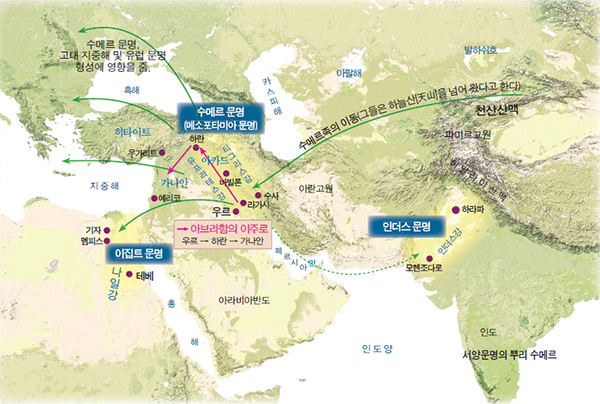수메르(SUMER) 건국

1. BC3000경,
교류가 없던 이집트 건국신화와 비슷한 시기에
수메르 지역을 지배하던 아카드(Akkad)인들과
바빌로니아 지역을 지배하던 쿠티아-인들을 몰아내고
수메르인의 우르-제3왕조를 열었다.
수호신(守護神, Guardian god) 남무(Lamma)의 화신으로 불리는
수메르 첫번째 왕이된 우르남무(BC2112-2075)에 의해 세워졌다고 한다
2. 훗날 수메르의 우르3왕조를 멸망시킨
셈(Semites, Semitic)계열의
아모리(Amurru,Amorite,수메르Martu)족 일파가 세운,
고-바빌로니아 함무라비왕(Hammurabi)시절,
BC1700년경,
아브라함은 아모리-갈대아인(바빌로니아,Chaldean)이 세운
갈대아-우르(UR of the Chaldeans)를 떠나
시리아(Syria)의 달의 신을 모시는
메소포타미아 하란(Haran)에 잠시 머물렀다가
팔레스타인의 세겜(Schchem0에 정착한다.
함무라비 왕조는 이집트와 자웅을 겨루게 되는
헷족속의 힛타이트왕(王) 무르실리스 1세에게 멸망 당한다.[1]
[1] 요하난 아하로니 외, The Carta Bible Atlas (아가페출판사, 2013, 서울)30
////////////////////////////////////////////////////////////////////////////////////////////////////////////////////////////////////
3. 수메르인은 함족이다.
수메르 우르에 수메르인으로 수메르 신들을 섬기며 살다,
그곳을 떠나간 '데라',
족장전승의 아브라함 일족은 함족일 가능성이 크다고 필자는 본다.
훗날 셈족의 아카드 그리고 아모리에게 멸망당해 사라진다.
다만, 가나안 지역에 정착했다는 사실로 인하여
셈족으로 부르는 것으로 보인다.
그렇지만 함족인 아브라함족과 달리
히브리전승의 모세의 일족의 히브리족은 셈족이 틀림없다.
왜냐하면 뒤에 나오는 이 에세이의 중심사건의 하나인,
가나안족(힉소스족)이 셈족이기 때문이다.
창세기 '족장전승'과 출애굽 '히브리전승'의 사이의 연결고리가
모세를 부르는데서 이뤄진다는 것에서도 유추할 수 있다.[1]’ [2]

[1] 김희권, 모세오경 (복있는 사람, 2017) p429
[2] Two tribes of Hamitic Peoples, Origins of Nations - Im Nin'alu (www.imninalu.net/peoples.htm)
*수메르 (Sumer), * 아프리카의 뿔 (Horn of Africa), * 인도 및 아라비아 (Arabia)와 같은 시기에
* 쿠시 (Kush)"로 알려진 4 가지 토지로 구별한다.
It is possible to distinguish at least four different lands which in some periods were known as "Kush": Sumer, the Horn of Africa, India and Arabia.


*가나안(KANA'AN),
그들은 현재 이스라엘, 레바논, 서부 시리아의 첫 번째 거주자였습니다.
그들은 "Phoenicians", 그리스 사람에 의해 그들에게 주어진 이름으로 역사에서 알려지지만,
그들은 스스로를 "Kan'ana"라고 불렀다.
가나안이라는 용어는
그 지역에 정착 된 사람들의 그룹, 특히 페니키아 인에게 적용됩니다.
이스라엘이 된 땅에 사는 가나안 사람들은 히브리 사람들과 결혼하여
이스라엘 사람들이 되었기 때문에 이스라엘 민족 정체성으로 동화 되었습니다.
Canaanites were the first inhabitants of present day Israel, Lebanon and Western Syria. They are known in history as "Phoenicians", the name given them by Greeks, but they called themselves "Kan'ana". The term Canaanites, then, is applied to a group of peoples settled in that area, and specifically to Phoenicians. Those Canaanites who inhabited the land that now is Israel were extinct as an ethnic identity, because they intermarried with Hebrews and became Israelites. Jews are among their present-day descendants.

※가나안(ˈkeˈnən)
■페니키아어: 𐤊𐤍𐤏𐤍 – KNʿN;[1]
■ 히브리어: כְּנַעַן – Kənáʿan, in pausa כְּנָעַן – Kənāʿan;
■ 성서 그리스어: Χανααν – Khanaan;[2 ]
■ 아랍어: كَنْعَانُ – Kan'ān)은 셈족
▷기원전 2천년 후반, 고대 근동의 남부 레반트 문명과 지역을 말함.
▷ 가나안은 후기 청동기 시대, 아마르나 시대(기원전 14세기)에
이집트, 히타이트, 미탄니, 아시리아 제국의
관심 영역이 수렴하거나 겹치는 지역으로
지정학적으로 중요한 중요성을 가지고 있었습니다.
▷ 가나안에 관한 오늘날의 많은 지식은 텔하조르, 텔므깃도, 엔에수르, 게제르와 같은
유적지에서 이 지역의 고고학적 발굴에서 유래합니다.
▷ "가나안"이라는 이름은
성경 전체에 걸쳐 "약속의 땅"과 관련된 지리로 나타납니다.
▷ "가나안인"이라는 악마어는
남부 레반트 또는 가나안 지역 전체에 걸쳐
정착민과 유목민, 목축 집단 모두를 포함하는
다양한 원주민 인구를 포괄하는 민족적 용어로 사용됩니다.[3]
▷ 이는 성경에서 가장 자주 사용되는 민족 용어입니다.[4]

▷ 성서학자인 마크 스미스(Mark Smith)는 고고학적 발견을 인용하여
"이스라엘 문화가 가나안 문화와 크게 겹치고 파생되었다고 주장합니다...
요컨대, 이스라엘 문화는 본질적으로 대부분 가나안 문화였습니다."[5]: 13–14 [6][7 ]
...가나안인과 이스라엘인이 근본적으로 다른 문화를 가진 사람들이라는
...오랫동안 지속된 모델에도 불구하고,
...고고학 데이터는 이제 이 견해에 의문을 제기합니다.
...이 지역의 물질 문화는 철기 I 시대(기원전 1200~1000년경)
...이스라엘인과 가나안인 사이에 수많은 공통점을 보여줍니다.
...기록을 보면 이스라엘 문화는 가나안 문화와 상당 부분 중복되고 파생된 것임이 드러난다.
...요컨대, 이스라엘 문화는 본질적으로 가나안 문화의 성격이 컸다.
...이용 가능한 정보를 고려할 때 철기 1기 시대에
...가나안인과 이스라엘인 사이에 급진적인 문화적 분리를 유지할 수는 없습니다.

▷ "가나안인"이라는 이름

은
후에 고대 그리스인들에게 알려진 사람들의 고유명으로 입증되었습니다.
기원전 500년 페니키아인으로서[8]
페니키아인과 가나안 사용자가 카르타고(기원전 9세기에 설립됨)로
이주한 후기 고대에 불리워 졌습니다.

The name "Canaan" appears throughout the Bible as a geography associated with the "Promised Land". The demonym "Canaanites" serves as an ethnic catch-all term covering various indigenous populations—both settled and nomadic-pastoral groups—throughout the regions of the southern Levant or Canaan.[3]
Brody, Aaron J.; King, Roy J. (1 December 2013). "Genetics and the Archaeology of Ancient Israel". Wayne State University. Archived from the original on 30 April 2018. Retrieved 9 October 2018.
It is by far the most frequently used ethnic term in the Bible.[4]
▶ Biblical scholar Mark Smith, citing archaeological findings, suggests "that the Israelite culture largely overlapped with and derived from Canaanite culture... In short, Israelite culture was largely Canaanite in nature."[5]
▶ Tubb, Johnathan N. (1998). Canaanites. British Museum People of the Past, vol. 2. University of Oklahoma Press. ISBN 9780806131085. Retrieved 9 October 2018.
: 13–14 [6][7]
- Smith, Mark S. (2002). The Early History of God: Yahweh and Other Deities of Ancient Israel. Wm. B. Eerdmans Publishing. pp. 6–7. ISBN 9780802839725. Archived from the original on 29 April 2024. Retrieved 9 October 2018. Despite the long regnant model that the Canaanites and Israelites were people of fundamentally different culture, archaeological data now casts doubt on this view. The material culture of the region exhibits numerous common points between Israelites and Canaanites in the Iron I period (c. 1200–1000 BC). The record would suggest that the Israelite culture largely overlapped with and derived from Canaanite culture... In short, Israelite culture was largely Canaanite in nature. Given the information available, one cannot maintain a radical cultural separation between Canaanites and Israelites for the Iron I period.
- Rendsberg, Gary (2008). "Israel without the Bible". In Greenspahn, Frederick E. (ed.). The Hebrew Bible: New Insights and Scholarship. NYU Press. pp. 3–5. ISBN 9780814731871. Archived from the original on 29 April 2024. Retrieved 9 October 2018.
The name "Canaanites" is attested, many centuries later, as the endonym of the people later known to the Ancient Greeks from c. 500 BC as Phoenicians,[8] and after the emigration of Phoenicians and Canaanite-speakers to Carthage (founded in the 9th century BC), was also used as a self-designation by the Punics (as "Chanani") of North Africa during Late Antiquity.
- Drews 1998, pp. 48–49: "The name 'Canaan' did not entirely drop out of usage in the Iron Age. Throughout the area that we—with the Greek speakers—prefer to call 'Phoenicia', the inhabitants in the first millennium BC called themselves 'Canaanites'. For the area south of Mt. Carmel, however, after the Bronze Age ended references to 'Canaan' as a present phenomenon dwindle almost to nothing (the Hebrew Bible of course makes frequent mention of 'Canaan' and 'Canaanites', but regularly as a land that had become something else, and as a people who had been annihilated)."
Shmuel Ahituv (1984). Canaanite Toponyms in Ancient Egyptian Documents. The Magnes Press, Hebrew University of Jerusalem. pp. 83–84.
'1. 출애굽 그리고 가나안 정착' 카테고리의 다른 글
| (5-3) 힉소스의 이집트 칩입 (0) | 2020.04.15 |
|---|---|
| 5-2. 고대 이집트 (0) | 2020.04.15 |
| 4. 출애굽의 전단계 -1 (0) | 2020.04.08 |
| (3-3) 설화(신화와 전설)와 역사 (0) | 2020.04.08 |
| (3-2) 성서와 숫자 (0) | 2020.04.04 |


